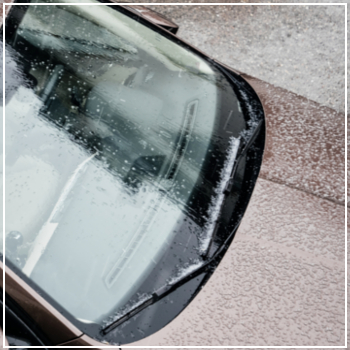 No matter where you live, hailstorms can be unpredictable. They might happen once in a blue moon or several times a year depending on your location. It's crucial to always think ahead and take steps to safeguard your car from possible damage.
No matter where you live, hailstorms can be unpredictable. They might happen once in a blue moon or several times a year depending on your location. It's crucial to always think ahead and take steps to safeguard your car from possible damage.
Generally speaking, the faster you can reach safety, the lower the chance of your car getting damaged. But circumstances play a big role here. If you're at home, pulling your car into the garage or covering it with a durable vehicle cover is a no-brainer. But what if you're out on the road? Finding a covered parking area or a sturdy awning becomes essential. Here are some practical tips to help you prepare for and respond to hail damage.
Stay Updated on Weather Conditions
Make sure to check the weather regularly on your phone, computer, or TV. If hail is forecasted, plan ahead by identifying covered parking spots along your route. Save those locations in your GPS so you can quickly navigate there if needed. Additionally, enable weather alerts on your phone to get instant updates about approaching storms.
Utilize Your Garage or Carport
Once you're back home, having a garage or carport makes it much easier to protect your car. For those who have a driveway but lack a garage, investing in a sturdy, fully enclosed carport that's securely anchored can provide significant protection against strong winds and hail.
Consider Car Covers
Even if you live in an urban area without access to a garage, you can still take measures to prevent hail damage. Look for a high-quality car cover made from thick, tear-resistant material. Ensure it covers the entire vehicle and can be tightly secured to avoid flying off during the storm. If you don't own a cover and hail is imminent, use household items like blankets or even floor mats to shield your car. Duct tape works well for securing these makeshift solutions.
Seek Out Covered Parking Areas
When you're out and about, aim for public parking garages such as those found at malls or gas stations. These structures often offer some degree of protection. Just be mindful of parking away from open walls and areas prone to strong winds. Be prepared to wait out the storm in your vehicle, and remember to drive cautiously afterward while keeping an ear on the weather updates.
Angle Your Car for Maximum Protection
During a hailstorm, the wind usually blows in one direction, causing the most damage to the side facing the wind. Whether you're parked outside or inside your driveway, positioning your car at an angle or shielding it with a temporary barrier can reduce the extent of damage. This might involve parking behind a fence or placing a portable screen in the direction of the wind.
Remember, comprehensive coverage under your auto insurance policy is necessary to cover hail damage repair costs. For paintless dent removal, consider reaching out to DaSilva’s Auto Body. Their Naugatuck location offers excellent service for restoring your vehicle to its original condition.
Ultimately, being proactive and informed about hail risks can save you both time and money in the long run. Stay safe and keep your car protected!
CAS NO.: 7758-29-4
EINECS NO.: 231-838-7
Sodium tripolyphosphate is an inorganic substance, also known as pentasodium tripolyphosphate, sodium tripolyphosphate, pentasodium phosphate, white crystal. Molecular weight 367.86. Soluble in water. Anhydrous and hexahydrate are common. The anhydrous matter is stable and the hydrate has hygroscopicity. The solubility of hexahydrate in water is less than that of anhydrous matter. It has good ability to complex metal ions and can complex with calcium, magnesium and iron to form soluble complexes. It has the functions of suspension dispersion, gelation and emulsification. It is mainly used as an additive for synthetic Detergent. It is also used as soft water agent, pretanning agent, dyeing assistant, etc. Using wet process phosphoric acid as raw material, neutralization reaction with sodium hydroxide was carried out by spray drying. Sodium tripolyphosphate is used as a softener, dispersant and dyeing assistant. It is used as softener for industrial water to reduce the content of calcium, magnesium, iron and other metal ions in industrial water and reduce the hardness of water; It is used as dispersant in industrial configurations such as paint, kaolin, magnesium oxide and calcium carbonate, and as dispersant for drilling mud. In addition, it can also be used as water reducer for detergent additives, food additives, gypsum and other molds.
Sodium Tripolyphosphate,Sodium Triphosphate,Food Grade Stpp,Stpp Sodium Tripolyphosphate
Henan Chuange Industry CO.,LTD , https://www.chuangegroup.com